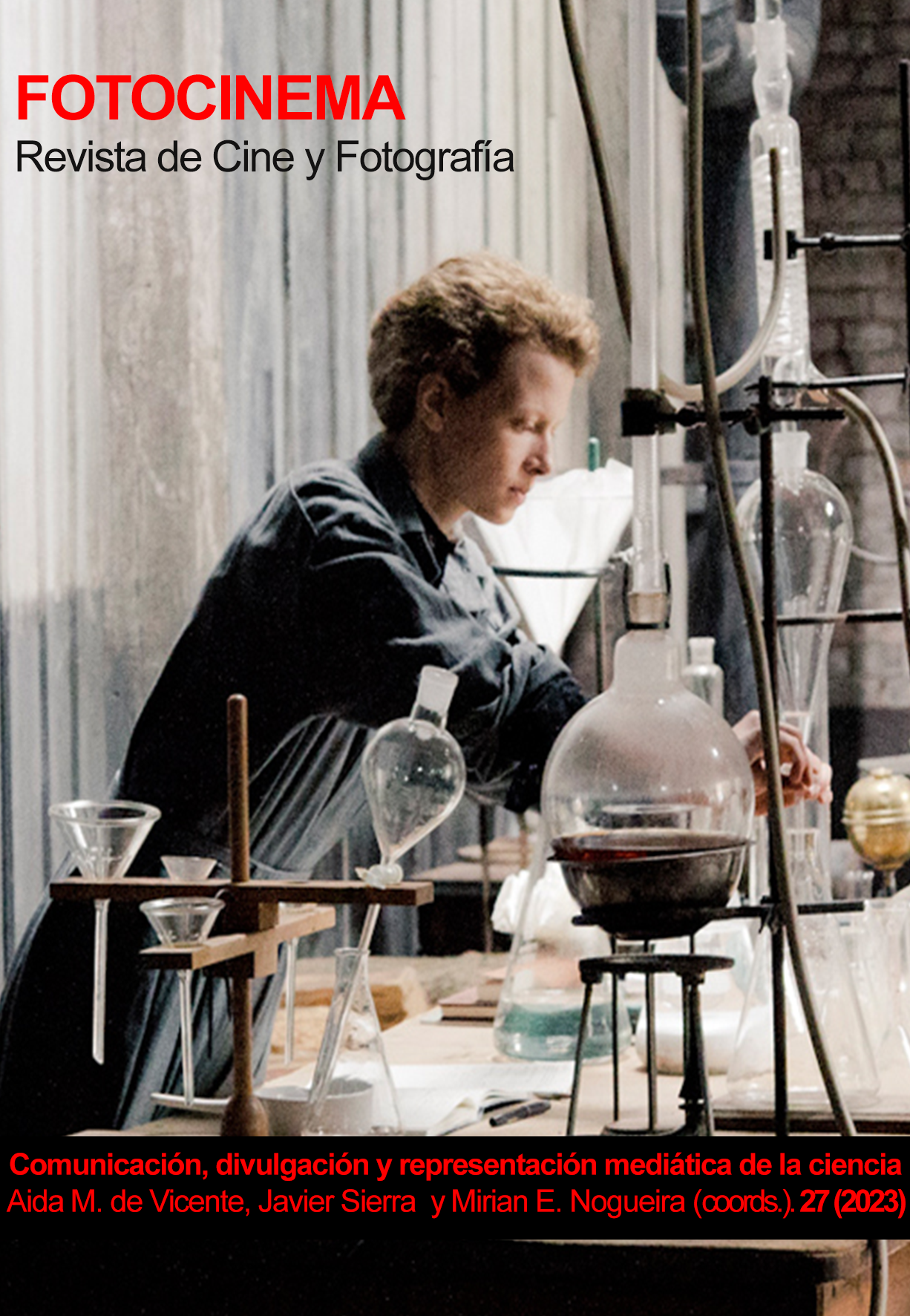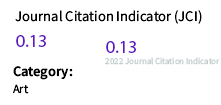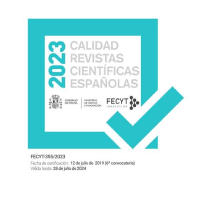Heterotopia, multiverses and time travel: the representation of science in Futurama and Rick & Morty
DOI:
https://doi.org/10.24310/Fotocinema.2023.vi27.16533Keywords:
Representation of science, heterotopia, multiverse, time travel, Futurama, Rick and MortyAbstract
This research aims to detect, codify and quantify the main scientific themes and problems presented in sitcoms Futurama and Rick & Morty with the aim of determining how scientific discourse is constructed, which science fiction subthemes are present and what type treatment receives science and the figure of scientists. Using a methodology based on grounded theory, the scientific disciplines and specific topics have been quantified and subsequently coded using variables in order to verify whether there is a direct relationship with a type of approach and representation of reality. From the discussion of the results, it is determined that the series do not reflect an apocalyptic and dystopian vision as science fiction cinema has historically done, although they present scientific concepts in a hyperbolized and inaccurate way, tending to ridicule both the scientific character as well as the physical and mathematical problems that arise. This precept leads to an interpretative duality that straddles between the demystification of stereotypes that demonize science and the projection of inaccurate axioms that can lead to an erroneous understanding of science by people.
Downloads
Metrics
References
Abesamis, L. (2019). Rick and Morty and Philosophy. In the beginning was the Squanch. Open Court Publishing Co.
Ardila Suárez, E. E., y Rueda Arenas, J. F. (2013). La saturación teórica en la teoría fundamentada: su delimitación en el análisis de trayectorias de vida de víctimas del desplazamiento forzado en Colombia. Revista Colombiana De Sociología, 36(2), 93–114. https://revistas.unal.edu.co/index.php/recs/article/view/41641
Balada, T. C., y Bovolenta Ovigli, D. F. . (2022). La ciencia como artefacto cultural: análisis de la narrativa cinematográfica en películas de ciencia ficción. Praxis & Saber, 13(32), e11986. https://doi.org/10.19053/22160159.v13.n32.2022.11986
Balló, J. y Pérez, X. (1995). La semilla inmortal. Los argumentos universales en el cine. Anagrama, Colección Argumentos.
Barca, L. (2005). As múltiplas imagens do cientista no cinema. Comunicação & Educação, 10(1), 31-39. https://doi.org/10.11606/issn.2316-9125.v10i1p31-39
Barceló, M. (2000). Paradojas: Ciencia en la ciencia ficción. Equipo Sirius.
Barceló, M. (2005). Paradojas II: Ciencia en la ciencia ficción. Equipo Sirius.
Birks, M., y Mills, J. (2014). Qualitative methodology: A practical guide. SAGE Publications.
Blomkamp, N. (Director). (2015). Chappie [Película]. Media Rights Capital.
Brady, M. (2019). The Science of Rick and Morty. The Unofficial Guide to Earth’s Stupidest Show. ATRIA.
Cameron, J. (Director). (1984) Terminator. [Película]. Orion Pictures.
Cameron, J. (Director). (1991) Terminator 2: Judgement Day. [Película]. TriStar Pictures.
Cameron, J. (Director). (2009) Avatar [Película]. 20th Century Studios.
Campo-Redondo, M. y Labarca Reverol, C. (2009). La teoría fundamentada en el estudio empírico de las representaciones sociales: un caso sobre el rol orientador del docente. Opción, 25(60). https://www.redalyc.org/articulo.oa?id=31012531004
Campos Arenas, A. (2021). Métodos mixtos de investigación. Magisterio.
Cigüela Sola, J., y Martínez Lucena, J. (2014). El imaginario social de la democracia en Black Mirror. Revista Latina de Sociología, 4(1), 90-109. https://doi.org/10.17979/relaso.2014.4.1.1223
Columbus, C. (Director). (1999) El hombre bicentenario [Película]. Buena Vista Pictures.
De Vicente, A.M. y Sierra Sánchez, J. (coords.). (2021) La representación audiovisual de la ciencia en el entorno digital. McGraw-Hill.
Durán Castro, M. (2016). Cuerpo y cine. El cuerpo en el cine y el cuerpo del cine. Arkadin, (5), 56–71. http://papelcosido.fba.unlp.edu.ar/ojs/index.php/arkadin/article/view/134
Durand, G. (2004). Las estructuras antropológicas del imaginario. Fondo de Cultura Económica.
Eldem, U. y Nay?r, B. (2022). Ethics and Technology: An Analysis of Rick and Morty. Open Philosophy, 5(1), 1-16. https://doi.org/10.1515/opphil-2020-0155
Elías, C. (2010). El cine como arma de destrucción masiva de la ciencia. Revista Iberoamericana de Física, 6(1), 2-3. http://www.feiasofi.net/images/revistaibfisica/num6/textos/foro.pdf
Fernández, A. (2021). Mors Dei, Vita Mea.Human, Transhuman, and Posthuman Identities in the TV Series Altered Carbon and Westworld. Revista Hélice, 7, (1), 79-98.
Ferrer, R. (2017). Apocalípticos y desintegrados. El final del mundo en el cine de las últimas cuatro décadas. Vegueta. Anuario de la Facultad de Geografía e Historia, (17), 85-109.
Ferrer, R. (2022). El artista demiúrgico. Creación de vida autónoma: de las estatuas animadas a los autómatas, homúnculos y replicantes. Anales Del Instituto De Investigaciones Estéticas, 44(120), 119–154. https://doi.org/10.22201/iie.18703062e.2022.120.2772
Freire, A. (2022). Los antihéroes no nacen, se forjan. Arco argumental y storytelling en el relato antiheroico. Editorial UOC.
Freire-Sánchez, A., Gracia-Mercadé, C. y Vidal-Mestre, M. (2022). Referentes intertextuales para la expansión y la profundidad en la creación de un universo narrativo transmedia. Estudio de caso: la saga Vengadores. Palabra Clave, 25(4), e2542. https://doi.org/10.5294/pacla.2022.25.4.2
Garland, A. (Director) (2014). Ex-Machina. [Película]. DNA Films, Film4 Productions.
Gastaca, I. Iturregui, V. (2022) Iconic avatars of the human and the nonhuman in I, Robot (2004) and Bicentennial Man (1999). Artnodes, (30), 1-13. https://doi.org/10.7238/artnodes.v0i30.402863
Glaser, B. (2014). Applying grounded theory: A neglected option. Sociology Press.
Hernández-Sampieri, R. y Mendoza, C (2018). Metodología de la investigación. Las rutas cuantitativa, cualitativa y mixta. McGraw Hill Education.
Hidalgo, A. L. (2020). Westworld: ¿Humanización de las máquinas o mecanización de los humanos? Saberes y prácticas. Revista De Filosofía y Educación, 5(2), 1–13. https://revistas.uncu.edu.ar/ojs3/index.php/saberesypracticas/article/view/3829
Ibáñez, G. (Director). (2014) Autómata [Película]. Millennium Entertainment
Jonze, S. (2013). Her [Película]. Warner Bros. Pictures.
Juraszeck, C. y Monteiro, R. (2020). Interfaces entre cinema, ciência e ensino: uma revisão sistemática de literatura. Pro-Posições, 31. https://doi.org/10.1590/1980-6248-2017-0190
Lenic, J. (Productor). (2018) Altered Carbon [Serie de televisión]. Netflix.
Lewis, C. (2014). Futurama and Philosophy: Pizza, Paradoxes, and...Good News! Createspace.
Maíllo, K. (Director). (2011). Eva [Película]. The Weinstein Company. Netflix.
Masís González, T., y Castro López, R. (2021). Distopías y la rebelión de las máquinas: Sobre los tópicos del Cyberpunk. Pensamiento Actual, 21(36), 131-138 https://doi.org/10.15517/pa.v21i36.47019
Monge Acuña, V. (2015). La codificación en el método de investigación de la Grounded Theory o Teoría Fundamentada. Innovaciones Educativas, 17(22), 77–84. https://doi.org/10.22458/ie.v17i22.1100
Moreno F. y Palibrk I. (2012). El lenguaje de la ciudad postpostmoderna: la Nueva Nueva York de "Futurama". Ángulo Recto. Revista de estudios sobre la ciudad como espacio plural, 4(1), 105-122. https://doi.org/10.5209/rev_ANRE.2012.v4.n1.39284
Nolan, J. y Joy, L. (2016-2020). Westworld [Serie de televisión]. Warner Bros-HBO.
Paláu Castaño, L. A. (2022). Autómata. Ciencias Sociales Y Educación, 11(21), 305-319. https://doi.org/10.22395/csye.v11n21a13
Pérez, J. P. (2016). Metodología de análisis del personaje cinematográfico: Una propuesta desde la narrativa fílmica. Revista Razón y Palabra, 20(95), 534-552. https://www.redalyc.org/articulo.oa?id=199550145034
Proyas, A. (Director). (2004) Yo, robot [Película]. 20th Century Fox.
Pullen, A., y Rhodes, C. (2013). Parody, subversion and the politics of gender at work: the case of Futurama’s ‘Raging Bender.’ Organization, 20(4), 512–533. https://doi.org/10.1177/1350508412447246
Quirantes Sierra, A. (2011). Física de Película: una herramienta docente para la enseñanza de Física universitaria usando fragmentos de películas. Revista Eureka sobre Enseñanza y Divulgación de las Ciencias, 8(3), 334-340. http://dx.doi.org/10.25267/Rev_Eureka_ensen_divulg_cienc.2011.v8.i3.09
Raimi, S. (Director). (2022). Dr. Strange and the Multiverse of Madness. [Película]. Walt Disney Studios.
Risner, J. (2016). Lo continuo y lo discontinuo: las heterotopias cinematograficas y el cine de genero latinoamericano contemporaneo. Hispanofila, (177), 207-220. https://link.gale.com/apps/doc/A502652780/LitRC?u=anon~92de1b01&sid=googleScholar&xid=ab558d00
Rodríguez, N. A. (2020). Semióticas de la transposición en nuevas pantallas: la construcción de distopía en" carbono alterado", una serie original de Netflix. TSN. Transatlantic Studies Network: Revista de Estudios Internacionales, 5(10), 81-93. https://doi.org/10.24310/TSN.2020.vi10.13645
Rodríguez, R. (Director) (2019). Alita: Batlle Angel [Película]. 20th Century Fox-Disney+.
Sánchez-Escalonilla, A. (2002). Guión de aventura y forja del héroe. Ariel.
Sanders, R. (Director) (2017). Ghost in the Shell [Película]. Paramount Pictures.
Sannazzaro, J. (2015) Science fiction as a spearhead for ethical reflection of the social uses of technology. ArtefaCToS. Journal of Science and Technology Studies, 5(1), 185–193. https://revistas.usal.es/cinco/index.php/artefactos/article/view/12428
Sequeiros Bruna C., Puente Bienvenido H., López Jiménez M. y Fernández Ruiz M. (2016). Juventud, cultura y NTICs: ¿triángulo o prisma?. Teknokultura. Revista de Cultura Digital y Movimientos Sociales, 13(2), 699-718. https://doi.org/10.5209/rev_TEKN.2016.v13.n2.53267
Scott, R. (Director). (1982) Blade Runner [Película]. Warner Bros. Pictures.
Spielberg, S. (Director). (2001) A.I. Artificial Intelligence [Película]. DreamWorks Pictures.
Taylor, A. J. (2009). Welcome to the world of tomorrow today: Matt Groening's Futurama as posthuman mediator. Theses Digitization Project. 3767.
Thompson, K. (2019). The Science of Futurama. BenBella Books.
Villeneuve, D. (Director). (2017). Blade Runner 2049 [Película]. Sony Pictures Releasing.
Whedon, J. (Director). (2015). Avengers: Age of Ultron [Película]. Walt Disney Studios Motion Pictures.
Downloads
Published
How to Cite
Issue
Section
License
All contents published in Fotocinema Revista científica de cine y fotografía are protected under the Creative Commons Attribution-NonCommercial-ShareAlike 4.0 International (CC BY-NC-SA 4.0) license. All about this license is available in the following link: <http://creativecommons.org/licenses/by-nc-sa/4.0>
Users can copy, use, redistribute, share and exhibit publicly as long as:
- The original source and authorship of the material are cited (Journal, Publisher and URL of the work).
- It is not used for comercial purposes.
- The existence of the license and its especifications are mentioned.
There are two sets of authors’ rights: moral and property rights. Moral rights are perpetual prerogatives, unrenounceable, not-transferable, unalienable, imprescriptible and inembargable. According to authors’ rights legislation, Fotocinema. Revista científica de cine y fotografía recognizes and respects authors moral rights, as well as the ownership of property rights, which will be transferred to University of Malaga in open access. The property rights are referred to the benefits that are gained by the use or the dissemination of works. Fotocinema. Revista científica de cine y fotografía is published in an open access form and it is exclusively licenced by any means for doing or authorising distribution, dissemination, reproduction, , adaptation, translation or arrangement of works.
Authors are responsable for obtaining the necessary permission to use copyrighted images.










.png)

13.png)




